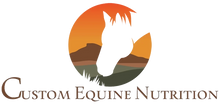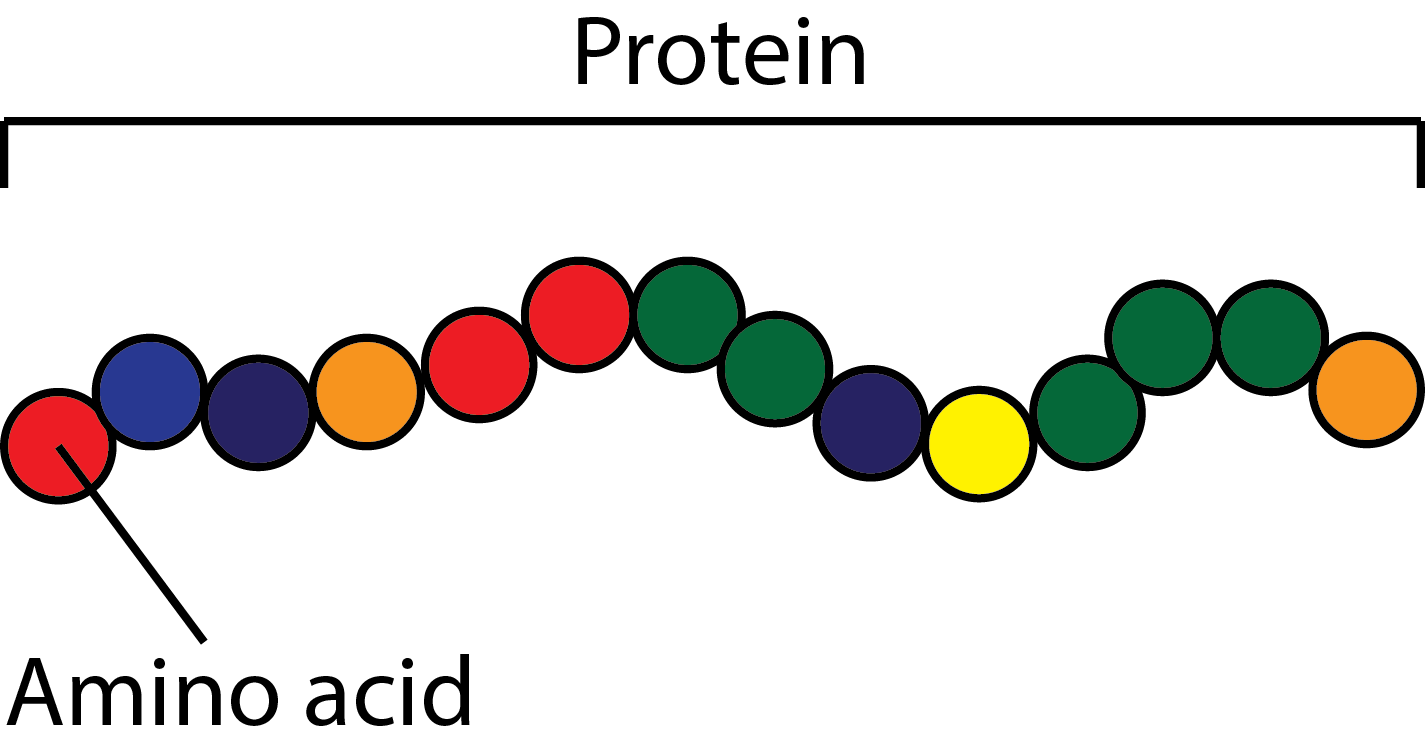Intro to Protein & Amino Acids
Protein is made up of individual amino acids. When your horse consumes protein, he breaks it down into individual amino acids and absorbs them into the blood stream. They can then be used to build different protein chains for the body (enzymes, cell structures, muscle protein, connective tissue, hoof, hair etc.). Protein makes up approximately 15% of total body mass. After water, it is the most abundant substance in your horses’ body.

Crude Protein
Crude Protein is the term you see listed on a hay analysis or feed tags guaranteed analysis. A typical scenario is walking into a feed store asking for a horse grain. The salesperson says “Sure, I have a 10% and a 14%, which would you like?”. This is a trick question. The percentage doesn’t matter as much as the amount that needs to be fed. A higher percentage doesn’t necessarily mean your horse will receive more protein. For example, if you feed a ration balancer that is 30% protein with a 1lb feed rate, your horse is getting 130 grams. Compare that to 22lbs of hay with 5% protein that provides 499grams.
Let’s compare some protein numbers!
Your average 1,100lb horse in light work needs 699 grams of crude protein per day.
|
Pounds of Hay (2% of body weight) |
Protein Percent |
Grams of Protein Provided |
|
22lb |
5% |
499g |
|
22lb |
8% |
798g |
|
22lb |
10% |
998g |
|
22lb |
12% |
1,197g |
According to Dairy One the average protein in grass hay is between 7-14%. As you can see from the chart above, hay will meet the daily crude protein requirements for most horses at maintenance or light work.
What about concentrates? The chart below compares various concentrates using the manufacturers recommended feed rate for a 1,100lb horse in light work.
|
Concentrate |
Pounds Per Day |
Protein Percent |
Grams of Protein Provided |
|
Senior |
6lb |
14% |
378g |
|
Ration Balancer |
1lb |
30% |
130g |
|
Low Starch |
6lb |
13% |
348g |
|
Training/Performance |
6lb |
14% |
378g |
Amino Acids
Meeting crude protein requirements is half of ensuring your horse has adequate protein. He also needs adequate amino acids.
Amino Acids are the building blocks of protein. There are 20 primary amino acids, which are broken down into two main categories: non-essential (dispensable) amino acids and essential (indispensable) amino acids. Non-essential amino acids can be manufactured by the horse. Essential amino acids need to be provided through the diet.
Think of amino acids like individual letters of the alphabet. You need to put those letters together to build a word, or in this analogy; a protein chain. Let’s say your horse needs to build some muscle. He pulls the specific letters from his amino acid alphabet to form the protein chain: M. U. S. L. C. E. But what happens if he has run out of the “U” amino acid? Then his protein chain would look like this: M. --- S. C. L. E. Without the “U” the protein chain for muscle can not be formed. Your horse will pull from his amino acid alphabet the protein chains that keep him alive first. Areas such as topline and hooves come afterwards. If there are not enough amino acids left over, he can not form these protein chains. These missing amino acids are called “Limiting Amino Acids” because how much the horse has limits the amount of protein that can be made. The most limiting amino acids are Lysine, Methionine and Threonine.
Another great analogy is Liebig’s Law of Minimum, using Liebig’s barrel to show how protein chains are limited by the amino acid in shortest supply.

Protein Sources
A variety of protein sources is key to ensure your horse has an adequate supply in his amino acid alphabet. Each protein source has different amino acids that your horse will break down and re-use. Examples of various sources are; grass, hay, legumes, grain, flax, wheat middling’s, split peas, chia seeds, etc.
Adding protein to a diet can also add calories. This can be tricky for easy keepers who need protein but not the calories. For these horses using a protein supplement is best. Whey protein isolate is a high-quality protein source. 1oz (28g) will provide approximately 25grams of protein. This can be combined with flax or chia to add to the amino acid alphabet without the extra calories.
Do you need to supplement?
Horses at maintenance or in light work will likely receive all the protein they need from hay and concentrates. Seniors, horses in heavy exercise, broodmares, and growing foals may benefit from extra protein. If your horse falls into any of those categories or shows signs of protein deficiency, supplement extra protein for a few months to see if you notice a difference. Examples of protein deficiency are poor hoof quality, lack of topline (possibly along with a pot belly appearance), weight loss, low energy, and poor coat quality.
How much do you need?
Lysine is the most important limiting amino acid. It is the only one that the NRC has a minimum requirement for. The current requirement for a 1,100lb horse in light work is 30g per day. Since there are no set requirements for Methionine and Threonine one can look at the ratios of amino acids in the horse’s muscles. With lysine being 100%, Threonine is 61% and Methionine is 27%. A safe guess for supplementation is 2.5-5g of methionine and 2-4g for Threonine.
Reading labels
Don’t be fooled, there are a lot of companies that have jumped on the “Topline” and Amino Acid bandwagon that have miniscule amounts. Some even claim to have miraculous results, yet the ingredient levels are clearly too low to back up their claims and carry a high price tag. If the amounts per serving are not listed on the label, call the company and ask them how many grams per serving. Make sure you are paying for something that will truly fill your horse’s amino acid alphabet.


